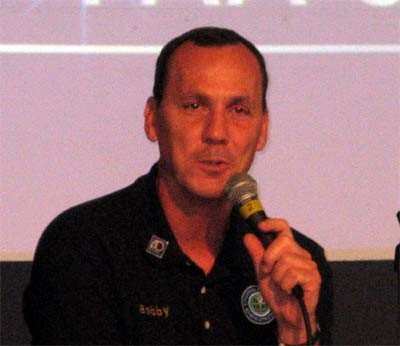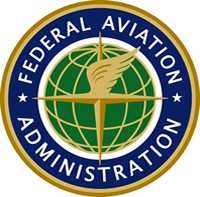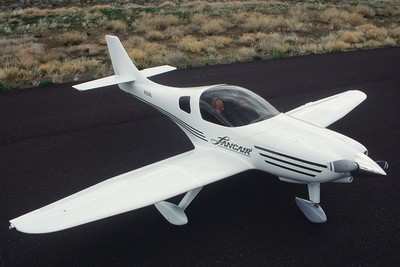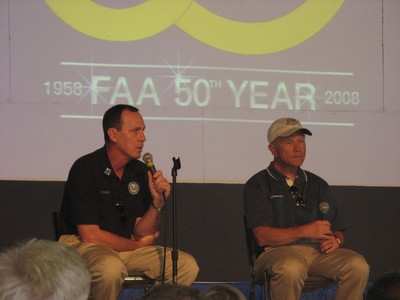Sturgell Makes His First Oshkosh Appearance As
Administrator
He came, and he talked... and he left many still unsure of what
kind of FAA Administrator Robert Sturgell will turn out to be,
should he be eventually confirmed for the job he now tenuously
holds with the qualifier "Acting" in front of his title.

Sturgell has been at AirVenture for several days, but he's kept
a relatively low profile. (He was present at a Monday meeting of
Congressional members with ties to aviation, for example, but he
declined to speak at it.) That's a marked departure from his
predecessor, Marion Blakey, who seemingly sought out bright lights
and microphones at every opportunity.
In his opening comments, Sturgell's low-key, affable nature
played well to the middling crowd at Thursday's forum... which was
a far cry from the packed houses Blakey drew during her tenure,
with several rows of seating in the Honda Pavilion left empty. But
Sturgell -- himself an accomplished military and commercial pilot,
another difference from his former boss -- knew how to appeal to
that audience.
 After allowing other FAA personnel in attendance to introduce
themselves (which led to a good-natured game of "whose ties to GA
are strongest?" during their intros) Sturgell paid heed to the four
winners of the FAA's General Aviation Awards Program for 2008: CFI
Max Trescott, FAAST Team Member John Teipen, Maintenance Technician
Mike Busch, and Avionics Technician Tim Adkison, who received their
honors Wednesday night at a Theater in the Woods presentation.
After allowing other FAA personnel in attendance to introduce
themselves (which led to a good-natured game of "whose ties to GA
are strongest?" during their intros) Sturgell paid heed to the four
winners of the FAA's General Aviation Awards Program for 2008: CFI
Max Trescott, FAAST Team Member John Teipen, Maintenance Technician
Mike Busch, and Avionics Technician Tim Adkison, who received their
honors Wednesday night at a Theater in the Woods presentation.
Sturgell then got down to business, giving EAA members some
insight into his position on the so-called "51 percent" rule, and
the FAA's efforts to modify it.
"As you know, we've got a proposed policy change for
homebuilts," Sturgell said. "It's come to our attention that some
companies may be skirting the letter of the law by selling a kit
that requires nothing more than two turns of a screwdriver. For
safety's sake, we just can't allow that. It's not right, and it
circumvents the very safeguards that are put in place to protect
everyone in the system.
"When we say that '51 percent of the plane has to be put
together by the builder and not the kit maker,' we mean it," he
continued. "In my opinion, 51 percent is appropriate. The aim here
of the policy change isn't to punish. It's for your safety and for
the integrity of the system."
That point segued into talk about the safety record of homebuilt
aircraft. "We've noticed a disturbing trend lately with
amateur-builts. Accidents and fatal accidents are increasing, both
in absolute numbers and in rates," Sturgell said. "In fact, the
fatal accident rate for this segment is three times as high as
Personal Use GA.
"We've got an active partnership with Tom [Poberezny, EAA
President] and his staff to try and bring these numbers down,"
Sturgell continued. "The General Aviation Joint Steering Committee
has formed a new subcommittee for amateur-built aircraft safety.
Earl Lawrence from EAA is co-chairing it, along with John Duncan of
Flight Standards."
Other members of the newly-created group, which met for the
first time Wednesday, includes GAMA [General Aviation Manufacturers
Association], LAMA [Light Aircraft Manufacturers Association], and
the Air Safety Foundation.
The need for such a committee seemed particularly apt. Though
few in the forum audience likely knew it at the time, Sturgell's
comments came within an hour of the fatal crash of a Lancair Legacy
on its final approach to land at Wittman Field... one of two fatal
accidents Thursday involving homebuilt aircraft nationwide.

Sturgell also addressed proposed changes to the light-sport
aircraft rule, and implored anyone with comments on the current
NPRM to weigh in. "Your feedback is vital to keeping the Light
Sport rule on course," he said. "We want to hear from you before
the comment period closes on August 13."
The administrator then turned his attention to matters of
interest to the pilot community as a whole -- the need for better
measures to prevent runway incursions, and recent FAA changes to
terms of first-and-third-class medicals for pilots under 40.
Sturgell then turned his attention to pitching the FAA's
much-ballyhooed "NextGen" air traffic control system.
"I can say that we're making solid progress," Sturgell said.
"The foundational technologies are either already in place or will
be soon enough. They include WAAS, which provides increased airport
access in reduced visibility conditions. We've published over 1,000
WAAS LPV procedures and we now have more of them than ILS
procedures.
"RNP/RNAV are also making a difference. Look at what's going on
at DeKalb Peachtree Airport in Atlanta. The new RNP procedure will
support IMC operations to runway 2R to a 340-foot decision height.
This mitigates obstacles on the approach path and de-conflicts
traffic flows around Peachtree and Hartsfield."

Sturgell concluded his prepared remarks by noting the FAA is
rolling out ADS-B procedures at several GA airports in the
southeastern US, including Boca Raton, Lakeland Linder, and Dade
Collier.
"So as you can see, we're moving confidently ahead with NextGen,
and it's with general aviation's well-being in mind," Sturgell
said. "Each and every one of you is a part of a remarkable history
that's being made at this very moment. If you want to know why it's
never been safer to fly, it's because of pilots like you. There's
nothing but blue skies ahead."
 Aero-News: Quote of the Day (04.28.25)
Aero-News: Quote of the Day (04.28.25) ANN's Daily Aero-Term (04.28.25): Decision Altitude (DA)
ANN's Daily Aero-Term (04.28.25): Decision Altitude (DA) ANN's Daily Aero-Linx (04.28.25)
ANN's Daily Aero-Linx (04.28.25) Airborne-Flight Training 04.24.25: GA Refocused, Seminole/Epic, WestJet v TFWP
Airborne-Flight Training 04.24.25: GA Refocused, Seminole/Epic, WestJet v TFWP Aero-News: Quote of the Day (04.29.25)
Aero-News: Quote of the Day (04.29.25)






